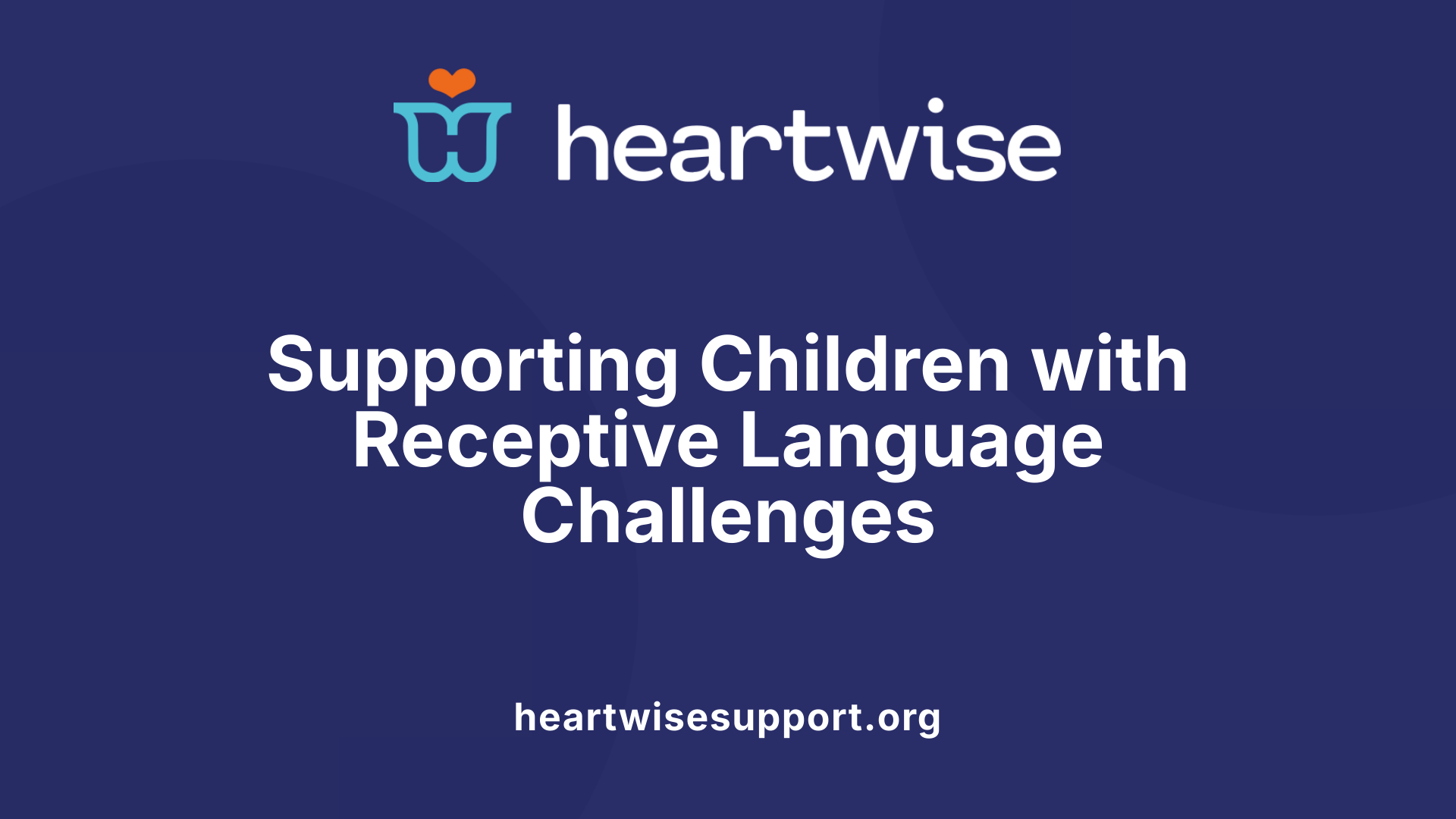Understanding Receptive Language and Its Crucial Role in Communication
Receptive language—the ability to understand spoken words, phrases, and concepts—is fundamental for effective communication, learning, and social interaction. It forms the foundation upon which expressive language is built, influencing a child's ability to participate in conversations, follow directions, and grasp new ideas. This article explores the nature of receptive language, signs of delays, the impact of speech therapy, and strategies to support development, particularly for children with developmental challenges like autism.
What Are Receptive Language Skills and How Do They Differ from Expressive Language?

What are receptive language skills and how are they different from expressive language skills?
Receptive language skills are a child's ability to understand and process spoken, written, or nonverbal language. These skills involve listening to words, sentences, and contextual cues to make sense of communication. For example, a child with good receptive language can follow simple instructions, identify objects when their names are spoken, or understand stories and questions.
In contrast, expressive language refers to how a child communicates their thoughts, needs, and feelings. This includes speaking, writing, gesturing, or using signs to express themselves. While receptive language focuses on understanding, expressive language is about producing understandable language to share ideas.
Both skills are connected; strong receptive language forms the foundation for expressive language development. If a child has difficulty understanding language, they may also struggle to communicate effectively. Challenges in receptive language can lead to delays in overall communication, literacy, and social interactions.
Supporting children in developing both receptive and expressive skills is essential. Effective strategies include engaging activities like reading, storytelling, and language games, as well as therapy approaches designed to target specific weaknesses. Speech-language pathologists often assess both areas to create tailored interventions, helping children improve their understanding and expression of language.
Understanding the difference between these skills highlights how crucial receptive language is for learning and social engagement. Fostering receptive language development early can significantly improve a child's ability to communicate and succeed academically and socially.
Identifying Signs and Causes of Receptive Language Difficulties

What are the signs of receptive language delays or difficulties?
Children with receptive language delays often show specific signs that can be observed by parents, caregivers, and teachers. One common indicator is their difficulty in understanding spoken language, which can include challenges following simple or multi-step instructions. Such children may frequently ask others to repeat themselves or seem distracted or inattentive during conversations.
Additionally, they might not respond appropriately to questions or may have trouble understanding jokes, stories, or figurative language. They may also show limited vocabulary comprehension and struggle with recognizing key concepts like before/after, in/on, or big/small. These difficulties can lead to frustration, withdrawal from social interactions, or reliance on gestures rather than verbal responses.
Early assessment by a speech-language pathologist is crucial to identify the depth of the problem. Proper diagnosis guides intervention strategies aimed at improving comprehension, which is fundamental for effective communication.
What causes poor receptive language development?
The development of receptive language skills can be impacted by various factors, although the exact causes are not always clear. Genetics can play a role, influencing language development from an early age. Limited exposure to rich language environments, such as inadequate interaction with caregivers or lack of access to educational resources, can hinder receptive language growth.
Certain health-related issues, including hearing impairments, visual difficulties, or neurological conditions like autism spectrum disorder or Down syndrome, are often associated with receptive language challenges. Developmental delays or cognitive impairments may also contribute, as these can affect a child's ability to process spoken information effectively.
Furthermore, environmental factors such as low socioeconomic status or limited early childhood stimulation can adversely impact receptive language skills. By understanding these possible causes, parents, educators, and health professionals can work together to create supportive interventions like speech therapy, targeted educational strategies, and enriching language activities to foster receptive language development.
The Role of Speech Therapy in Improving Receptive Language
Does speech therapy help with receptive language issues?
Yes, speech therapy can be highly effective for children facing receptive language challenges. A certified speech-language pathologist (SLP) conducts detailed assessments to identify specific difficulties, such as trouble understanding instructions, grasping vocabulary, or following stories and concepts. Based on this evaluation, the SLP designs individualized treatment plans that target areas like comprehension, language processing, and listening skills.
Therapy typically involves engaging activities that promote understanding through fun and interactive methods. These may include visual supports like picture schedules, repeated modeling of language, and exercises that focus on responding to questions or following directions. Early intervention proves especially valuable, as addressing receptive language delays early can significantly enhance overall communication and learning abilities.
Sessions can be conducted in person or virtually, providing flexibility for families. Throughout therapy, children learn to better comprehend spoken language, which in turn improves their social interactions, academic success, and daily functioning.
What are common activities and interventions to develop receptive language skills?
To foster receptive language development, several evidence-based activities are used by speech therapists and caregivers.
Listening Games:
- "Simon Says" enhances the child's ability to follow simple and multi-step directions.
- Memory and "I Spy" games encourage attention and understanding of language cues.
Reading and Storytelling:
- Reading books aloud introduces new vocabulary, sentence structures, and story comprehension.
- Narrating actions and describing objects help reinforce understanding of concepts.
Visual and Tactile Aids:
- Picture cards, graphic organizers, and visual cues support comprehension, especially for children with language processing difficulties.
- Simplifying instructions, emphasizing key words, and breaking tasks into manageable steps aid understanding.
Play-Based Interventions:
- Obstacle courses, pretend play, and interactive tasks promote listening and concept development.
- Structured activities designed by therapists incorporate reinforcement and prompt response strategies to improve stimulus control.
Involving speech therapists ensures that these activities are tailored to the child's individual needs, making intervention more effective. Overall, consistent, playful, and supportive practices help children develop stronger receptive language skills, laying the foundation for expressive abilities and ongoing communication growth.
Activities and Strategies to Support Receptive Language Development

What activities and interventions support receptive language skills?
Supporting receptive language development involves a variety of engaging activities and targeted interventions. Reading aloud to children and discussing the story enhances vocabulary and comprehension. Playing name recognition games, such as locating objects when their names are called, helps children associate spoken words with visual stimuli. Interactive games like 'Simon Says' improve the child's ability to follow simple instructions, while 'I Spy' encourages listening and categorization skills.
Visual cues and gestures integrated into daily routines foster understanding of spoken language. For instance, pointing to objects or pictures as the child names them reinforces concept recognition. Interventions also include breaking down complex instructions into manageable steps, utilizing visual aids such as picture schedules, and modeling correct responses to prompts.
Activities targeting understanding of concepts, such as size (big/small), location (in/on), and categories (fruits, clothing), can be done through playing with blocks, sorting tasks, or using real objects. This hands-on approach helps children grasp abstract ideas and improve their overall comprehension.
Collaborating with speech-language pathologists ensures that activities are tailored to the child's specific needs. Repetition and positive reinforcement during activities solidify learning, while environmental adjustments like quiet areas help children focus and process spoken instructions better.
How can caregivers and teachers foster receptive language skills at home and in school?
At home and in school, adults play a crucial role in nurturing receptive language skills. Creating a language-rich environment by regularly reading stories and narrating daily activities encourages children to connect words with actions and objects. Pointing to items while naming them or commenting on what the child is doing helps build understanding.
Using visual aids such as picture charts, gesture prompts, and visual schedules can clarify routines and instructions. Asking open-ended questions, like "What do you see?" or "Can you point to the big ball?", invites children to interpret spoken language and respond appropriately.
Breaking spoken instructions into smaller, clear steps and giving children time to process each part enhance understanding. Consistent feedback and gentle prompts reinforce their comprehension skills.
Play-based learning activities—such as simple board games, interactive digital apps, or peer interactions—serve as excellent opportunities for meaningful practice. Incorporating technology like audiobooks, educational videos, or learning apps provides additional auditory input and engages children in receptive language tasks.
Overall, patience, consistency, and creating supportive environments at home and school help children develop strong receptive language skills, laying a foundation for successful communication and learning.
The Importance of Assessment and Early Intervention
How can receptive language be improved in children?
Receptive language development can be significantly enhanced through various practical strategies. Clear and simple speech, along with short instructions, helps children understand instructions more effectively. Visual aids, like pictures and gestures, serve as valuable tools to reinforce understanding. Engaging activities such as reading books, playing listening games like 'Simon Says' and 'I Spy,' and narrating actions create enriching learning opportunities.
Repetition and modeling by caregivers or therapists reinforce comprehension, while confirming understanding through follow-up questions ensures that children are grasping the intended message. Minimizing distractions in learning environments allows children to focus better on instructions and conversations. Early intervention is vital; speech therapy and specialized programs targeting vocabulary, listening skills, and the ability to follow multi-step directions can foster growth.
Involving caregivers and practicing consistently at home further boost receptive language abilities, leading to better communication skills over time.
Supporting Children with Receptive Language Delays and Autism
 Children with receptive language delays often face challenges in understanding spoken language, instructions, and social cues. These difficulties are especially common among children with autism spectrum disorder (ASD). In ASD, receptive language skills tend to lag behind expressive skills, making it harder for children to process and respond appropriately to spoken communication.
Children with receptive language delays often face challenges in understanding spoken language, instructions, and social cues. These difficulties are especially common among children with autism spectrum disorder (ASD). In ASD, receptive language skills tend to lag behind expressive skills, making it harder for children to process and respond appropriately to spoken communication.
Early intervention and specialized therapies can significantly improve receptive language abilities. Speech-language therapy plays a central role, utilizing assessments to identify specific weaknesses and creating personalized treatment plans. These plans often incorporate techniques like visual supports, picture exchange systems, and naturalistic teaching to help children better interpret spoken language.
Strategies such as using visual schedules, concrete examples, and giving children ample response time enhance understanding. Environmental modifications, including sensory-friendly settings and augmentative communication devices, support children's processing of language.
In educational contexts, support involves simple and clear instructions, routine structures, and engaging activities like storytime or role-playing, which bolster comprehension. Collaboration among speech-language therapists, teachers, and families ensures consistent and effective reinforcement of receptive language skills.
Supporting children with autism specifically benefits from visual aids like PECS, visual schedules, and environmental adaptations that create a receptive and engaging learning environment. These approaches help children understand and respond to spoken language, promoting social participation and academic success.
Overall, with early, targeted support strategies tailored to each child's needs, children with receptive language delays—including those with ASD—can achieve better communication, understanding, and social integration, fostering overall development and confidence.
Conclusion and Future Directions in Receptive Language Therapy
 Receptive language therapy offers significant benefits for children struggling with understanding spoken language. Tailored interventions help improve their ability to follow directions, comprehend stories, and grasp concepts, which can positively influence overall development and learning.
Receptive language therapy offers significant benefits for children struggling with understanding spoken language. Tailored interventions help improve their ability to follow directions, comprehend stories, and grasp concepts, which can positively influence overall development and learning.
Recent research continues to explore innovative approaches, such as combining visual supports, engaging activities, and technology-based tools, to enhance receptive language skills. These strategies aim to increase engagement and optimize outcomes, especially for children with developmental disabilities like autism spectrum disorder.
Looking ahead, the future of receptive language therapy appears promising, with ongoing studies promising new techniques and tools to support children more effectively. Advances may include more personalized digital applications, augmented reality experiences, and improved assessment methods to identify needs earlier and tailor interventions precisely.
Overall, continued research and innovation will likely lead to more effective, accessible, and engaging therapy options, helping children reach their full communication potential.
The Path Forward: Early Intervention and Tailored Strategies
Receptive language is a vital component of effective communication and learning. Speech therapy, through comprehensive assessment and tailored interventions, plays a crucial role in supporting children with receptive language difficulties. Early identification and intervention are key to maximizing progress, especially for children with developmental challenges like autism. By incorporating evidence-based activities, visual supports, and caregiver involvement, speech-language pathologists can foster meaningful improvements that enhance overall communication skills. Continued research and innovation in this field promise more effective therapies, ensuring every child has the opportunity to understand and engage with their environment confidently.
References
- Expressive vs. Receptive Language - TherapyWorks
- Treatments for Receptive Language Disorders in Children
- Teaching Receptive Language Skills: Recommendations for ...
- Receptive Language Skills and Child Development - PedsTeam
- How Speech Therapy Can Help Develop Receptive Language
- Receptive Language Delay: Speech Therapy and Activities
- The 6 Most Productive Receptive Language Activities - Bilinguistics











